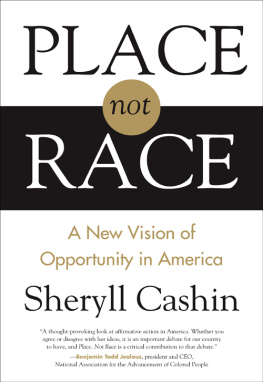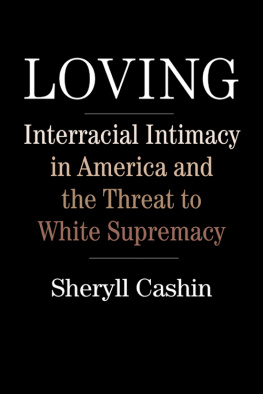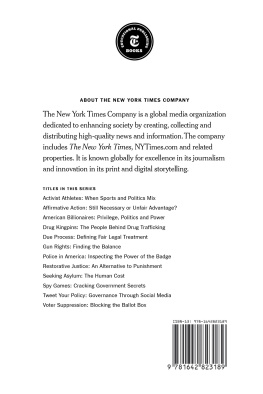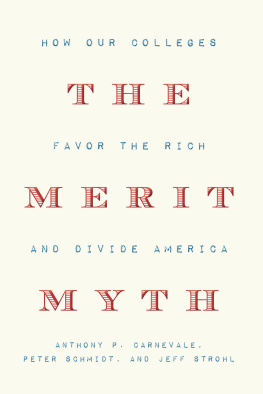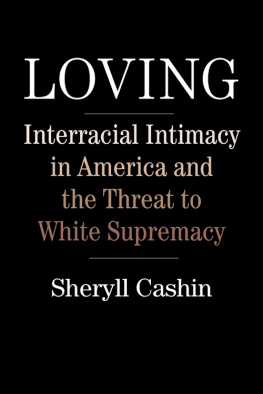OTHER BOOKS BY SHERYLL CASHIN
The Agitators Daughter: A Memoir of Four Generations of One Extraordinary African-American Family
The Failures of Integration: How Race and Class Are Undermining the American Dream

For Logan and Langston,
with faith that your generation will be better.
INTRODUCTION
This book is about fairness. The US economy has become a pyramid in which nearly three-quarters of the jobs that will become available in this decade are predicted to pay a median wage of less than $35,000 a year and require only a high school diploma or less.
Those blessed to occupy golden neighborhoods and schools are most likely to enter equally golden colleges. Intentionally or not, they can block access by those outside their advantaged networks through in-group sanctioned practices like legacy preferences, merit aid, and the overuse of standardized test scores that track income status. Ironically, race-based affirmative action may also contribute to the hoarding phenomenon because advantaged racial minorities are most likely to benefit from the policy, and, as I argue, the optical diversity this creates undermines the possibility that elite colleges will rethink exclusionary practices.
In this book, I challenge universities to reform both affirmative action and the entire admissions process. But hoarding of selective education is only one strain of the unfairness that pervades America. My aim is to begin a larger conversation about how to create a politics of fairness that will help the vast majority of Americans who will not attend Harvard, Yale, or the University of Illinois.
A professional black woman describes to me her sisters fury when black children from low-income neighborhoods were given preferences to improve their access to sought-after magnet programs in Chicago public schools. The sister was angry when her middle-class black kids who did not live in the hood did not gain entrance, although they had better academic records. Is this what America has come toa country where advantaged people of all colors look at growing inequality and are reduced to invoking numerical standards that block out others, and complaining when those others do gain access? Is this the country you want to live in, dear reader?
FAIRNESS IN COLLEGE ADMISSIONS
Abigail Fisher had a complaint that resonated with most Americans. The cherub-faced strawberry blond wanted her dream school, the University of Texas, to evaluate her and her competitors without any consideration of race. She did not want to be seen as a white girl from a suburb named Sugar Land, presumably the wrong race and place in a withering competition that has gone global. Nor did she think it fair that other applicants might benefit from having more melanin. There were people in my class with lower grades who werent in all the activities I was in, who were being accepted into UT, and the only difference between us was the color of our skin, she said in a YouTube video posted by her lawyers.
Her argument is one weve heard before. Blacks and Latinos with lower test scores and grades than hers got in and that, she concluded, violated her right to equal protection under the Constitution. It didnt matter to Fisher or her lawyers that forty-two white applicants with lower numbers than hers were also admitted. They focused on the theoretical possibility that the five applicants of color with lower scores who gained entrance may have succeeded where Fisher failed, solely because of their race.
Who knows for certain why Fisher did not emerge from ambiguity? Had she graduated in the top 10 percent of her high school class, she would have gained automatic entrance to the flagship university that both her father and sister attended. Instead she and other less stellar applicants had to compete head to head for the remaining 19 percent of slots in the UT Class of 2012. Her application probably landed in the maybe pile, its occupants neither obvious admits nor rejects. These are the applications conscientious admissions officers agonize over. A strong, authentic voice crying out from an absorbing personal essay or a soaring letter of recommendation that rings as true can make the difference.
In addition to high school rank and standardized test scores, UT considered personal achievement based upon two essays and factors like leadership, extracurricular activities, community service, work experience, socioeconomic status, andthe eternal bugaboorace. Fishers argument that race played a definitive role certainly resonates with how most white people feel about affirmative action in higher education. They think it is unfair to them and their children, and this explains why many institutions have been retreating from considering race in admissions.
The Supreme Courts 2013 compromise decision in Fisher v. Texas extended the life of race-based affirmative action. But there will always be another Abigail Fisher. When a disgruntled applicant sues, defenders of an affirmative action policy must convince the court that there are no workable race-neutral alternatives to achieve the educational benefits of diversity. Conservatives will continue to attack the policy in courts and through politics. With one exception, every time the issue of affirmative action has been placed on a state ballot, voters have banned the policy. As this book went to print, the Supreme Court had heard argument but not issued a decision in the case of Schuette v. Coalition to Defend Affirmative Action, in which the ability of Michigan voters to ban affirmative action is challenged. At oral argument, conservative justices seemed inclined to uphold the ban. However the court rules, political opposition to use of race in college admissions will continue.
This is particularly easy politics for Republicans. On the day Barack Obama was re-elected president, voters in Oklahoma approved an amendment to their state constitution to prohibit affirmative action based upon race, gender, ethnicity or national origin in public employment, education, and contracting. At the time this was the third ban successfully sponsored by Republican state legislators in three years. They no longer needed a black man, Ward Connerly, for cover. Political mobilization against affirmative action accords with the mood of a browning country in which white guys increasingly feel victimized. White anxiety about changing demographics shows up in online comments like one by Andrew, who identified himself as living in the South. Opining on a New York Times story about California universities that had responded to a state ban on racial preferences by spending as much as $85 million on outreach and mentoring to expand the pipeline of college-ready applicants of color, Andrew wrote:
Diversity = fewer white people, even in places where white people are already a minority, both in terms of their representation in the general population and their presence on campuses. If judges ban affirmative action, the ideologues who run our institutions of higher education will simply ignore the law and proclaim holistic admission practices in order to decrease the number of white students admitted, much as they have done in California, Michigan and elsewhere in recent years.
His was among the most recommended comments on the story, presumably because it resonated with many white readers. White anxiety will continue to rise as more whites become minorities in their states or communities. Institutions necessarily are changing to accommodate domestic demographic change and globalization. The future is Rice University: today, at this preeminent school founded on a whites-only charter, less than half of the undergraduates are white Americans. At Rice, native students of color and international students are taking places that literally were once reserved for white people, and some whites are not dealing well with such transitions.

